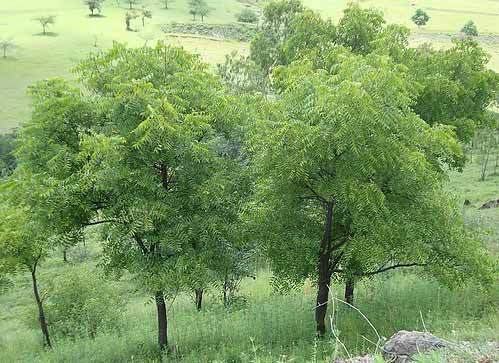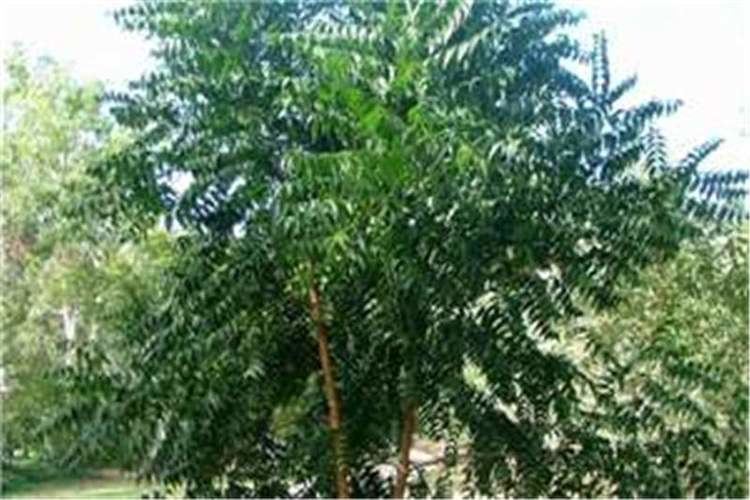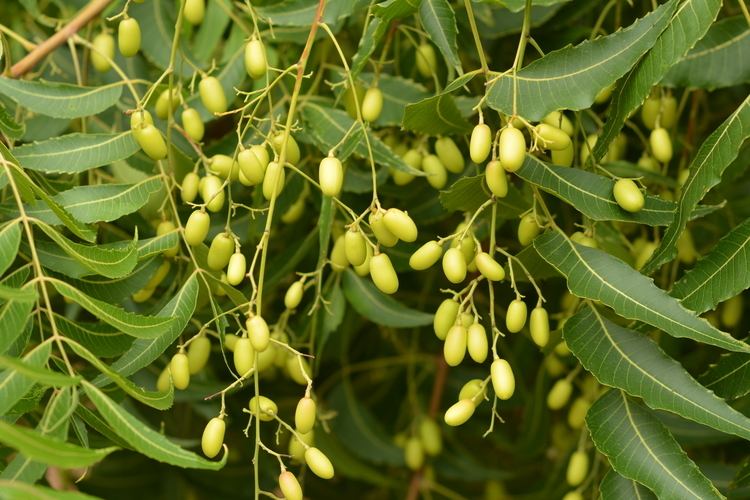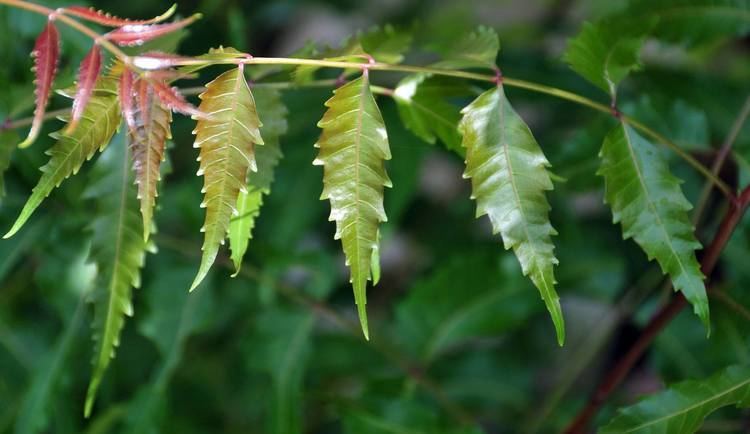Genus Azadirachta Rank Species | ||
 | ||
Similar Turmeric, Triphala, Gum trees, Fenugreek, Mango | ||
Azadirachta indica the wonder herb
Azadirachta indica, also known as Neem, Nimtree, and Indian Lilac is a tree in the mahogany family Meliaceae. It is one of two species in the genus Azadirachta, and is native to India and the Indian subcontinent including Nepal, Pakistan, Bangladesh, and Sri Lanka. It typically is grown in tropical and semi-tropical regions. Neem trees now also grow in islands located in the southern part of Iran. Its fruits and seeds are the source of neem oil.
Contents
- Azadirachta indica the wonder herb
- Description
- Etymology
- Vernacular names
- Ecology
- Weed status
- Uses
- As a vegetable
- Traditional medicinal use
- Safety issues
- Pest and disease control
- Neem oil for polymeric resins
- Construction
- Other uses
- Association with Hindu festivals in India
- Chemical compounds
- Genome and transcriptomes
- Cultural and social impact
- Symbolism
- Biotechnology
- References
Description

Neem is a fast-growing tree that can reach a height of 15–20 metres (49–66 ft), and rarely 35–40 metres (115–131 ft). It is evergreen, but in severe drought it may shed most or nearly all of its leaves. The branches are wide and spreading. The fairly dense crown is roundish and may reach a diameter of 15–20 metres (49–66 ft) in old, free-standing specimens. The neem tree is very similar in appearance to its relative, the Chinaberry (Melia azedarach).

The opposite, pinnate leaves are 20–40 centimetres (7.9–15.7 in) long, with 20 to 31 medium to dark green leaflets about 3–8 centimetres (1.2–3.1 in) long. The terminal leaflet often is missing. The petioles are short.

The (white and fragrant) flowers are arranged in more-or-less drooping axillary panicles which are up to 25 centimetres (9.8 in) long. The inflorescences, which branch up to the third degree, bear from 150 to 250 flowers. An individual flower is 5–6 millimetres (0.20–0.24 in) long and 8–11 millimetres (0.31–0.43 in) wide. Protandrous, bisexual flowers and male flowers exist on the same individual tree.

The fruit is a smooth (glabrous), olive-like drupe which varies in shape from elongate oval to nearly roundish, and when ripe is 1.4–2.8 centimetres (0.55–1.10 in) by 1.0–1.5 centimetres (0.39–0.59 in). The fruit skin (exocarp) is thin and the bitter-sweet pulp (mesocarp) is yellowish-white and very fibrous. The mesocarp is 0.3–0.5 centimetres (0.12–0.20 in) thick. The white, hard inner shell (endocarp) of the fruit encloses one, rarely two, or three, elongated seeds (kernels) having a brown seed coat.
Etymology
Neem (नीम) is a Hindi noun derived from Sanskrit Nimba (निंब).
Vernacular names
Names for this plant in various languages include;

Ecology

The neem tree is noted for its drought resistance. Normally it thrives in areas with sub-arid to sub-humid conditions, with an annual rainfall of 400–1,200 millimetres (16–47 in). It can grow in regions with an annual rainfall below 400 mm, but in such cases it depends largely on ground water levels. Neem can grow in many different types of soil, but it thrives best on well drained deep and sandy soils. It is a typical tropical to subtropical tree and exists at annual mean temperatures of 21–32 °C (70–90 °F). It can tolerate high to very high temperatures and does not tolerate temperature below 4 °C (39 °F). Neem is one of a very few shade-giving trees that thrive in drought-prone areas e.g. the dry coastal, southern districts of India, and Pakistan. The trees are not at all delicate about water quality and thrive on the merest trickle of water, whatever the quality. In India and tropical countries where the Indian diaspora has reached, it is very common to see neem trees used for shade lining streets, around temples, schools and other such public buildings or in most people's back yards. In very dry areas the trees are planted on large tracts of land.
Weed status
Neem is considered a weed in many areas, including some parts of the Middle East, most of Sub-Saharan Africa including West Africa and Indian Ocean states, and some parts of Australia. Ecologically, it survives well in similar environments to its own, but its weed potential has not been fully assessed.
In April 2015, A. indica was declared a class B and C weed in the Northern Territory, Australia, meaning its growth and spread must be controlled and plants or propagules are not allowed to be brought into the NT. It is illegal to buy, sell, or transport the plants or seeds. Its declaration as a weed came in response to its invasion of waterways in the "Top End" of the territory.
After being introduced into Australia, possibly in the 1940s, A. indica was originally planted in the Northern Territory to provide shade for cattle. Trial plantations were established between the 1960s and 1980s in Darwin, Queensland, and Western Australia, but the Australian neem industry did not prove viable. The tree has now spread into the savanna, particularly around waterways, and naturalised populations exist in several areas.
Uses
Neem leaves are dried in India and placed in cupboards to prevent insects eating the clothes, and also in tins where rice is stored. Neem leaves are dried and burnt in the tropical regions to keep away mosquitoes. These flowers are also used in many Indian festivals like Ugadi. See below: #Association with Hindu festivals in India. As an ayurvedic herb, neem is also used in baths.
As a vegetable
The tender shoots and flowers of the neem tree are eaten as a vegetable in India. A souplike dish called Veppampoo charu (Tamil) (translated as "neem flower rasam") made of the flower of neem is prepared in Tamil Nadu. In West Bengal, young neem leaves are fried in oil with tiny pieces of eggplant (brinjal). The dish is called nim begun and is the first item during a Bengali meal that acts as an appetizer. It is eaten with rice.
Neem is used in parts of mainland Southeast Asia, particularly in Cambodia aka sdov—ស្ដៅវ, Laos (where it is called kadao), Thailand (where it is known as sadao or sdao), Myanmar (where it is known as tamar) and Vietnam (where it is known as sầu đâu and is used to cook the salad gỏi sầu đâu). Even lightly cooked, the flavour is quite bitter and the food is not enjoyed by all inhabitants of these nations, though it is believed to be good for one's health. Neem gum is a rich source of protein. In Myanmar, young neem leaves and flower buds are boiled with tamarind fruit to soften its bitterness and eaten as a vegetable. Pickled neem leaves are also eaten with tomato and fish paste sauce in Myanmar.
Traditional medicinal use
Products made from neem trees have been used in India for over two millennia for their medicinal properties. Neem products are believed by Siddha and Ayurvedic practitioners to be Anthelmintic, antifungal, antidiabetic, antibacterial, antiviral, contraceptive, and sedative. It is considered a major component in siddha medicine and Ayurvedic and Unani medicine and is particularly prescribed for skin diseases. Neem oil is also used for healthy hair, to improve liver function, detoxify the blood, and balance blood sugar levels. Neem leaves have also been used to treat skin diseases like eczema, psoriasis, etc.
Insufficient research has been done to assess the purported benefits of neem, however. In adults, short-term use of neem is safe, while long-term use may harm the kidneys or liver; in small children, neem oil is toxic and can lead to death. Neem may also cause miscarriages, infertility, and low blood sugar.
Safety issues
Neem oil can cause some forms of toxic encephalopathy and ophthalmopathy if consumed in large quantities.
Pest and disease control
Neem is a key ingredient in non-pesticidal management (NPM), providing a natural alternative to synthetic pesticides. Neem seeds are ground into a powder that is soaked overnight in water and sprayed onto the crop. To be effective, it must be applied repeatedly, at least every ten days. Neem does not directly kill insects on the crop. It acts as an anti-feedant, repellent, and egg-laying deterrent, protecting the crop from damage. The insects starve and die within a few days. Neem also suppresses the hatching of pest insects from their eggs. Neem cake is often sold as a fertilizer.
Neem oil has been shown to avert termite attack as an ecofriendly and economical agent.
Neem oil for polymeric resins
Applications of neem oil in the preparation of polymeric resins have been documented in the recent reports. The synthesis of various alkyd resins from neem oil is reported using a monoglyceride (MG) route and their utilization for the preparation of PU coatings. The alkyds are prepared from reaction of conventional divalent acid materials like phthalic and maleic anhydrides with MG of neem oil. In other reports, different routes for preparation of polymeric resins from neem oil also are reported.
Construction
The juice of this plant is a potent ingredent for a mixture of wall plaster, according to the Samarāṅgaṇa Sūtradhāra, which is a Sanskrit treatise dealing with Śilpaśāstra (Hindu science of art and construction).
Other uses
Association with Hindu festivals in India
Neem leaf or bark is considered an effective pitta pacifier because of its bitter taste. Hence, it is traditionally recommended during early summer in Ayurveda (that is, the month of Chaitra as per the Hindu Calendar which usually falls in the month of March – April).
In the Indian states of Telangana, Andhra Pradesh and Karnataka, Neem flowers are very popular for their use in 'Ugadi Pachhadi' (soup-like pickle), which is made on Ugadi day. In Telangana, Andhra Pradesh, and Karnataka, a small amount of Neem and Jaggery (Bevu-Bella) is consumed on Ugadi day, the Telugu and Kannada new year, indicating that one should take both bitter and sweet things in life, joy and sorrow.
During Gudi Padva, which is the New Year in the state of Maharashtra, the ancient practice of drinking a small quantity of neem juice or paste on that day, before starting festivities, is found. As in many Hindu festivals and their association with some food to avoid negative side-effects of the season or change of seasons, neem juice is associated with Gudi Padva to remind people to use it during that particular month or season to pacify summer pitta.
In Tamil Nadu during the summer months of April to June, the Mariamman temple festival is a thousand-year-old tradition. The Neem leaves and flowers are the most important part of the Mariamman festival. The statue of the goddess Mariamman will be garlanded with Neem leaves and flowers. During most occasions of celebrations and weddings the people of Tamil Nadu adorn their surroundings with the Neem leaves and flowers as a form of decoration and also to ward off evil spirits and infections.
In the eastern coastal state of Odisha the famous Jagannath temple deities are made up of Neem heart wood along with some other essential oils and powders.
Chemical compounds
Ayurveda was the first to bring the anthelmintic, antifungal, antibacterial, and antiviral constituents of the Neem tree to the attention of natural products chemists. The process of extracting neem oil involves extracting the water-insoluble components with ether, petrol ether, ethyl acetate, and dilute alcohol. The provisional naming was nimbin (sulphur-free crystalline product with melting point at 205 °C, empirical composition C7H10O2), nimbinin (with similar principle, melting at 192 °C), and nimbidin (cream-coloured containing amorphous sulphur, melting at 90–100 °C). Siddiqui identified nimbidin as the main active antibacterial ingredient, and the highest yielding bitter component in the neem oil. These compounds are stable and found in substantial quantities in the Neem. They also serve as natural insecticides.
Neem-coated urea is being used an alternate to plain urea fertilizer in India. It reduces pollution, improves fertilizer's efficacy and soil health.
Genome and transcriptomes
Neem genome and transcriptomes from various organs have been sequenced, analyzed, and published by Ganit Labs in Bangalore, India.
ESTs were identify by generation of subtractive hybridization libraries of neem fruit, leaf, fruit mesocarp, and fruit endocarp by CSIR-CIMAP Lucknow.
Cultural and social impact
In Theravada Buddhism, the neem tree is said to have been used to achieve enlightenment (bodhi) by Tissa, the twentieth reincarnation of Lord Buddha. Some sources claim, however, that Terminalia tomentosa was the Bodhi tree used.
In 1995, the European Patent Office (EPO) granted a patent on an anti-fungal product derived from neem to the United States Department of Agriculture and W. R. Grace and Company. The Indian government challenged the patent when it was granted, claiming that the process for which the patent had been granted had been in use in India for more than 2,000 years. In 2000, the EPO ruled in India's favour, but W. R. Grace appealed, claiming that prior art about the product had never been published in a scientific journal. On 8 March 2005, that appeal was lost and the EPO revoked the Neem patent.
Symbolism
Previously, neem had been declared as the national tree of the former Hyderabad State, now defunct.
Biotechnology
The biopesticide produced by extraction from the tree seeds contains limonoids. Currently, the extraction process has disadvantages such as contamination with fungi and heterogeneity in the content of limonoids due to genetic, climatic, and geographical variations. To overcome these problems, production of limonoids from plant cell suspension and hairy root cultures in bioreactors has been studied, including the development of a two-stage bioreactor process that enhances growth and production of limonoids with cell suspension cultures of A. indica.
